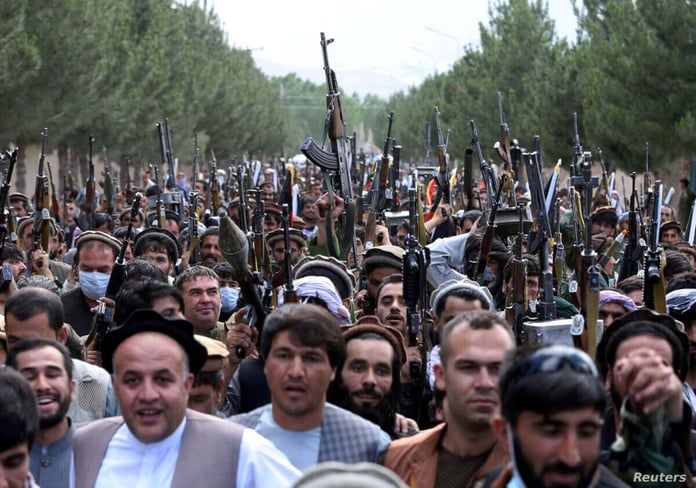
After two decades of fighting, the Taliban took control of Afghanistan for the first time since 2001, so people, especially young people, may face a radically different way of life from that they have known in twenty years, according to the American newspaper, ” Los Angeles Times .”
The question whose answer the coming days and months will reveal is, have the ideas of that fundamentalist movement changed from what it was when it ruled the country for the first time in 1996 and announced an “Islamic Emirate” that imposed strict and extremist rules on the people? The movement’s spokesman from Qatar, Suhail Shaheen, had emphasized more than once that his group would respect women’s rights, especially in the fields of work and education.
The Taliban movement first came to power in Afghanistan in the 1990s by faction fighters who expelled Soviet forces in the past decade, most of whom are Pashtuns, the country’s largest ethnic group.
The late cleric, Mullah Muhammad Omar, founded the movement in 1994 to impose law and order in the southeastern city of Kandahar after the spread of crime and violence in it, which made people accept it at first.
“At the time, people really wanted law and order,” says Kamran Bukhari of the New Lines Institute, a foreign policy think tank, telling The Washington Post that it was a priority for them.
In the fall of 1996, the Taliban took over the capital, Kabul, to exercise a brutal and repressive rule, depriving women of most of their basic rights and forcing them to wear clothes that did not show anything of her face and body, and the media was also banned, music and all other forms of art were banned, and males were forced to Wearing beards and not wearing western fashion.
The Taliban’s ideology was similar to that of al-Qaeda, but it limited its presence to Afghanistan without declaring itself a cross-border movement, but at the same time rejected any pressure on it to expel the leaders of terrorist groups such as al-Qaeda, which led to the American intervention in the country after the September 11 attacks.
Recently, however, the armed group has sought to present a more positive image of it, and its leaders issued statements that sought to reassure Afghans and the international community that it would not loot or kill government employees and officials, both military and civilians, in addition to ensuring the safety and security of embassies and international missions. and charities that will be allowed to continue their work without concern.
Their goal is simple and clear
Currently, the Taliban’s goal is simple, and Robert Cruz, an expert on Afghanistan at Stanford University, defines it in restoring what the group lost in the early 2000s, saying: “They want their Islamic Emirate to return to power and implement their vision of Sharia.”.
He continued, “They do not want a parliament or local elections. They have an emir of the mullahs’ assembly, and this is the vision that they see as the best for governing the country.”
However, the group’s recent actions contradict reports that the Taliban have closed girls’ schools in the areas they have recently taken over, and that they have prevented women from going to their workplaces, asking them to send their male relatives in their place. These reports also indicated that some families were forced to marry their underage daughters to the militants of the Taliban movement.
For its part, the Los Angeles Times reported that the movement re-imposed harsh penalties and established borders against civilians, noting that it had hanged two men from Helmand province during the past month after they were convicted of kidnapping children, and kept their bodies swaying from the top of a bridge for several days, but a spokesman The Taliban denied this incident, asserting that it was merely malicious propaganda to tarnish the image of his group.
On the other hand, experts believe that Afghanistan has witnessed the emergence of civil society in the past two decades that did not exist before, as women occupied public positions not only in Kabul but even in cities and small towns, as people spread through phones and were accustomed to surfing the Internet and using social networking sites. social.
“The people have changed”
Here, observers wonder whether the Taliban will be able to rule a people that have undergone all these drastic changes, to which Cruz answers: “Many Afghans have become better connected to the world through platforms and will therefore protest if they are imposed on a hardened lifestyle.”
He added, “What will Taliban leaders do about a society that believes in pluralism and refuses to monopolize power? To what extent will the movement’s violence be able to silence those voices?”
Thomas Ruttig, co-director of the Afghan Analysts Network, says in a research paper that although the movement has “softened its rhetoric on some issues” such as the status of women, the changes are largely the result of political pressure rather than a radical shift in its ideas and beliefs.
He noted that, given their persistent authoritarian behavior, and intolerance of political opposition and repression (particularly towards girls and women) in the areas they control, there is a legitimate concern that if political pressure wanes after a final peace agreement and troop withdrawal, they may return to their pre-Khareef practices. the year 2001″.













